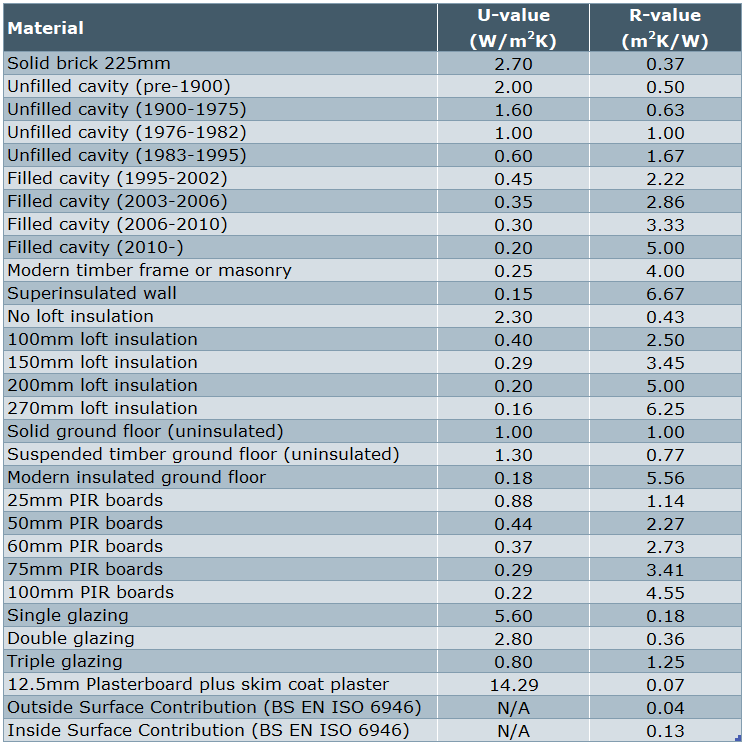R-Values and U-Values
The performance of insulation products is measured using R-values and U-values. A good insulation system will have a high R-value but a low U-value.
Table of R- and U-values for common building and insulation materials. Refer to Insulation Materials for more details of each
The R-value is the thermal insulance (or resistance)
A higher R-value means a better insulating effect. It is calculated by -
R = L/k (units m²K/W)
Where “L” is the thickness of the insulation and “k” is the thermal conductivity (a measure of how good it is at transferring heat. )
So, to increase the R-value you can increase the thickness of your insulation or use a more efficient insulating material which will have a lower conductivity.
The combined R-value of a system is simply the R-values of each component added together, e.g. R(wall) + R(insulation)
The U-value is the thermal transmittance
It it the reciprocal of the R-value (i.e. 1 divided by R) and so a lower U-value means a better insulating effect.
U = 1/R = k/L (units W/m²K)
U-values are commonly used to measure the insulating performance of a whole insulating system (e.g. brick wall plus insulation plus plasterboard plus plaster). Maximum U-values are defined in the Building Regs so it’s important to be able to calculate them to pick a suitable thickness of insulation.
To calculate the U-value of a combined system (e.g. brick wall plus insulation) you would add the R-values of the individual components, then divide one by the sum -
U total = 1 / (R1 + R2)
Comparison of insulation materials
Table of common insulation materials, the market leading products in each category, and the thickness and approximate cost to achieve a typical U-value of 0.2. N.B. U-value requirements may be higher or lower depending on the usage - please refer to Building Regs for further info.
* PIR and glass wool are the most commonly-used materials for wall and loft insulation respectively.
Calculating Insulation Thickness - Worked Example
If your existing wall is solid brick 225mm thick, and you want to add PIR insulation, what thickness is required?
Building Regs give a U-value for upgraded existing walls of 0.3 so we need to achieve a U-value less than this.
Therefore our total R-value must be at least 1/0.3 = 3.33
From the table above, the R-values for the existing brick wall, plus contributions from the plasterwork and external and internal surfaces are:
0.37 + 0.07 + 0.04 + 0.13 = 0.61Therefore the required R-value for the insulation alone is 3.33 - 0.57 = 2.72
Selecting from the table above, we would need at least 60mm of PIR insulation (R = 2.73) to achieve a U-value of 0.3.
Tool Kit
Links connect to suitable products on external sites. Please contact us if you notice any broken links.






